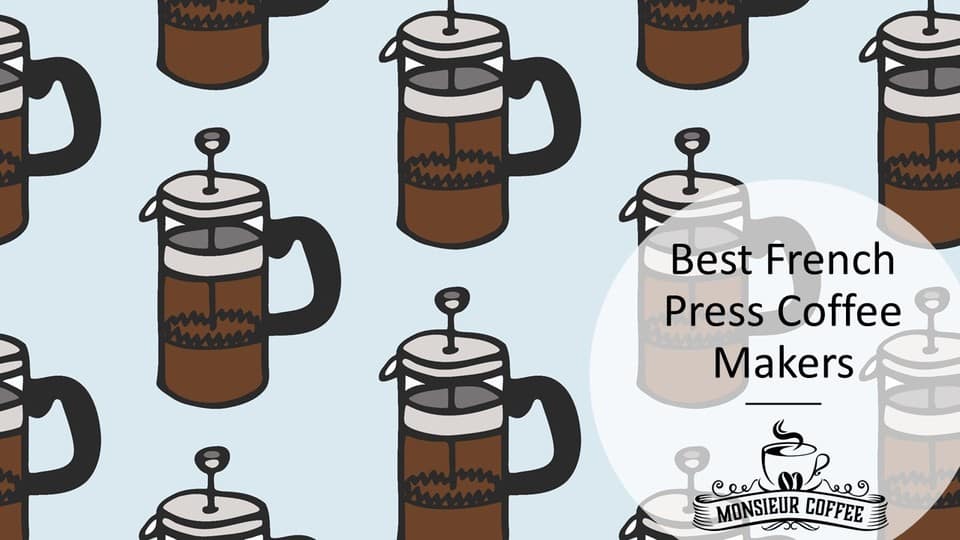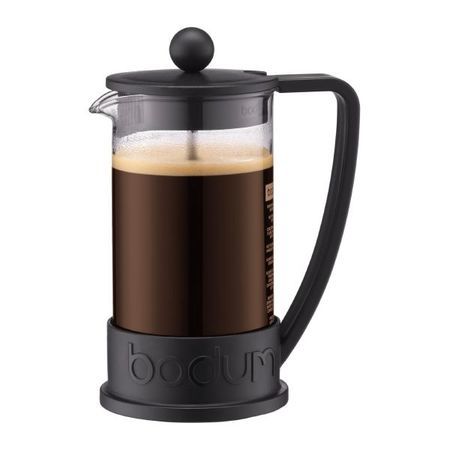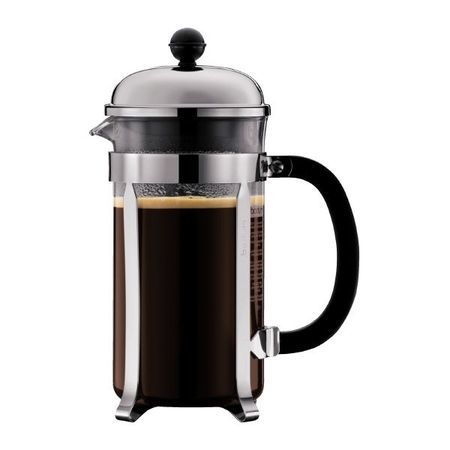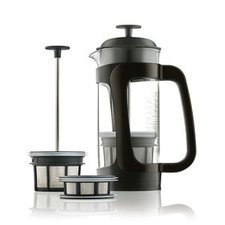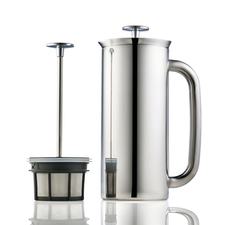The French Press is one of the most commonly used devices to brew coffee. The device is known as a French Press in the U.S. and Canada, but had different names across the world. In New Zealand, Australia, and South Africa it is known as a coffee plunger. The Dutch and the British use the shortened French name: cafetière. The official French name is cafetière à piston, but the French mostly use trademarks as Bodum and Melior.
Below are the French Presses we take a look at:

- Bodum Brazil
- most affordable French Press which produces decent coffee. Best value for money
- Bodum Chambord
- better build quality than the Brazil, produces the same decent quality coffee. Still very affordable.
- Espro Press P3
- produces the best coffee at a very reasonable price.
- Espro Press P7
- produces the same high quality coffee as the P3, but with a stainless steel (and pricey) body.
For me the Espro Press P3 is the clear winner. It gives you the advantages of a French Press brew, while avoiding any grit in your coffee by utilizing an innovative mesh filter. The price difference between the Espro Press P3 and the Bodum Brazil is justified because the build quality of the Espro is better and the quality of the coffee is just so good. But still, the Bodum Brazil is a really great budget option.
We’ll take an in depth look at these press pots in a bit.
But first, let’s answer an essential question:
Why Use a French press?
Many people consider the French Press to be the ultimate coffee making device. The full immersion brewing, long steeping time and rough filtering (mesh filter vs. paper filter) preserves the delicate oils in the coffee beans resulting in a smooth, rich and full bodied cup of coffee.
Combined with the ease of use – it takes about four minutes to brew coffee in a French Press – and the relatively low costs – you can get a great French Press for about $20 – also makes it an outstanding choice for coffee lovers on a budget.
Add to that the fact that it takes op no counter space and you have a winner.
There is one thing you need to take in consideration. Not everyone likes the coffee that comes from a French Press. The full-bodied and textured taste of pressed coffee is accompanied by a flavor that is best described as ‘muddy’. The French Press’s mesh screen allows more fine parts to remain in your coffee than when you use a paper filter. This causes the robust and oily flavor of the coffee to be accentuated, but the more delicate flavors of some types of coffee beans are lost.
It’s all a matter of taste, I guess.
A Bit of french press history
The exact origins of the French Press are shrouded in mystery. Both the French and the Italians (of course) claim the invention of the first French Press-like coffee maker. One thing we know for sure is that French Presses first appeared in the 1850s in France.
Legend has it that a man from the Provence invented the French Press by accident. This man supposedly to daily trips up a hill to escape his nagging wife. Whether the wife was really nagging, or the man was a complete a-hole is lost to history. Anyway, rain or shine, the man took his journey any day he could. He would always take with him a small amount of food, some firewood and his favorite old coffee pot. Upon reaching the top of the hill, the man would take a nap, light a fire, eat his food and… brew some coffee.
The conventional method for brewing coffee in those days was to mix the grounds with cold water and heat it over a fire until the water boiled. If you know anything at all about making coffee, you’ll understand that the coffee in those days tasted horrible. Boiling water destroys the oils in coffee, losing all flavor.
At one fateful day the man was making coffee as usual, at the top of the hill. This time he forgot to add the coffee grounds to the water before boiling it. When the water started boiling, the man realized his mistake. He removes the pot from the flames, took a moment to ponder what to do (allowing the water to cool) and decided to add the coffee grounds anyway.
To the man’s dismay, the grounds floated to the top, making the coffee undrinkable. By chance, at that exact moment, an Italian merchant appeared at the horizon. The man wondered whether the merchant would have anything among his wares to allow him to push the coffee down. He ran toward the merchant to find out. The merchant happened to carry a piece of metal screen. The man bought it and used a stick to push the coffee down to the bottom of the pot. When he tasted the coffee, the man was flabbergasted. He had never tasted coffee this nice in his life!
The story continues with the man and the merchant deciding to improve on the design and to start producing coffee pots with a metal screen that could be plunged down. Their invention made them small fortunes.
If you think this story is quite farfetched… yeah, me too.
Folklore is nice, but we know that the first registered patent for a French Press was lodged far later in 1929 by an Italian, Attilio Calimani from Milan.
After the improvements of Calimani, there were some refinements in the late fifties. But the design of the French Press was set. Modern innovations resulted in a few different types of French Presses.
What to look for in a French press
A French Press is a relatively simple device. It nothing more than a glass or stainless steel carafe or beaker with a plunger that has a mesh filter on the bottom. That’s really it.
Most French Presses are made of a special kind of glass: borosilicate. You need a special type of material to withstand the large and sudden changes in temperature the device is exposes to. Imagine pouring boiling water in a wine glass. Chances are, it will crack (do no try this at home, it can de dangerous).
Another option is a stainless steel French Press. Stainless steel will not crack as easy as glass – even borosilicate – and is therefore far more durable. Downside is that a stainless steel French Press is usually quite a bit more expensive to compared to a glass French Press. Most stainless steel French Presses advertise with the added feature of having double walled constructions for better heat retention. In my opinion this is a pretty useless feature. When you let coffee sit in a French Press after it has been plunged it will still be in contact with the coffee grounds at the bottom of the pot. This contact means that the brew will quickly over-extract and will taste bitter. My advice: pour the coffee in a different container immediately after plunging. If you make a batch of multiple cups of coffee you need to keep warm, use a vacuum flask or travel mug. If you consider buying a stainless steel French Press, buy it for durability, not for heat retention.
The carafe or beaker in a glass French Press is usually set in a plastic or metal base. A base that is easily removeable allows for the press pot to be cleaned without a hassle. Most metal based French Presses require a screwdriver to remove the base. This makes the base a bit sturdier, but makes the cleaning more difficult. In my experience, just rinsing the French Press without removing the base is enough to clean it most of the time. I find that I only clean my metal based French Press (Bodum Chambord) when it is really nasty, and that only happens after heavy use. I clean my plastic based French Press (Bodum Brazil) far more often. I pop of the base, put the beaker and the base in the dishwasher, et voila!
It is really a matter of preference. Do you value build quality over how easy it is to clean the thing?
The plunger is the other important part of the French Press. A good French Press has a plunger that has a tight fit in the beaker of the press. This ensure that the ground don’t end up in your coffee. The filter itself should be a mesh screen over a metal disk. When pressing coffee down into the pot, the filter shouldn’t warp or wiggle and the mesh should be fine enough to keep anything but the finest grit out of the coffee. With a French Press you will never achieve a cup of coffee as clean and bright as with a pour over method, but you shouldn’t have to chew your coffee.
French Press coffee maker come in a variety of sizes. Mostly, sizes are states in fluid ounces or in cups. I recommend looking at the capacity of a French Press by looking at the ounce capacity. Cups are measured differently across manufacturers and this can cause confusion or worse, you could end up buying the wrong size press pot. For most people I would recommend a 32 to 34 ounce (0.95 to 1 liter) French Press. While it still allows you to make coffee for multiple people in one go, making 1 large cup is also possible.
Essential accesories for using a french press
As any coffee aficionado will tell you, you can go nuts with accessories. My advice, keep it simple. A simple digital kitchen scale for weighing out coffee beans and a decent kettle to boil water is basic equipment.
And a coffee grinder of course.
I recommend using a coffee grinder than can produce a consistent grind size on a coarse grind setting. The French Press requires a pretty coarse grind and some coffee grinders can’t handle coarse grinds as well as finer settings. These grinders generally produce a grind with a lot of fines on a coarser setting, which can really mess up your coffee. The mesh filters in a French Press allow the finest of fines to get into your coffee. Especially the last bit in your cup will then taste gritty.
If you consider buying a manual coffee grinder, the Porlex JP-30 is a really great option. When you prefer an automatic coffee grinder, the Baratza Virtuoso offers the best value for money.
You can find more information on these grinders in our round up of the best manual coffee grinders and the best automatic coffee grinders.
how to brew coffee in a french press
Making coffee in a French Press is easy. Coffee and hot water, that’s all.
Eh… as it is with all types of milk-less coffee.
The water to coffee ratio depends on the kind of roast you are using. With lighter roast you should use a 14 to 1 or a 15 to 1 ratio. This means that on a 32-34 ounce (or 0,95 to 1 liter) French Press you should use about 63 grams. If you use a darker roast a slightly higher ratio is better. Go for a 16 to 1 or 17 to one ration, which is about 58 grams per 32-34 ounces (0,95 to 1 liter) of water.
The coffee should be ground fairly coarse. The longer extraction time asks for a coarser grind to prevent over extraction (which results is bitterness), but more importantly a coarser grind prevents the coffee grounds from passing through the filters. You want as little grit as possible to end up in your cup. The picture is a good indication for the grind size you are looking for. If by any chance you are using a Baratza Virtuoso or a Bartaza Encore automatic coffee grinder, go for a grind setting between 30 and 32. If you are more into hand operated burr grinders and you happen to have a Handground Precision, go for grind setting 6 o 7.
Put the ground coffee in the pot, set a timer for four minutes, and pour in a splash of water to wet the grounds. After one minute you can add the rest of the water and wait for the timer to reach zero. Then plunge and immediately pour out the coffee, either in a (few) cup(s) or in a vacuum flask. Enjoy!
The first wetting of the grounds is called degassing or blooming and allows the coffee to disperse any natural gas buildup. It might seem like an unnecessary step, but it improves the taste of the final brew. At least in my opinion. You can try adding all the water at once and see if you taste the difference. If you add all the water at once it is advisable to stir the coffee after 1 minute to allow for a proper extraction. Coffee tends to float to the surface and the ‘bloom’ as this is called should be knocked back at least once during the brew process.
The temperature of the water you pour on should be around 200 degrees Fahrenheit or 90 degrees Celsius. If you don’t have a kettle that brings the water up to a specific temperature, wait for 30 seconds after the water has finished boiling (lid open!). The total amount of water you pour should be 32-34 ounces or 0,95 to 1 liter of water. The easiest way to achieve this is to boil the exact amount of water you need by measuring what you put into you kettle. Another option is to weigh the water while pouring it in. Do this by putting the French Press including the coffee grounds on your kitchen scale, press ‘tare’ (brings the scale to zero) and pour in a total of 1000 grams of water.
Making coffee mean experimenting. The type of coffee, the roast, the grind size, the amount of water, it all influences the flavor of the final brew.So, the measurements in the brew method above are absolutely not set in stone. Experiment with grinds a little coarser or finer than stated and add a little more or a little less water. Be careful when increasing or decreasing the amount of coffee you put in. You should absolutely experiment but know that putting in more coffee, doesn’t automatically give you more flavor.
One final tip: record you experiments. It is great to be able to see and learn how tweaking little things impacts taste. Soon you’ll be able to brew your perfect cup of coffee.
french press coffee maker reviews
In the sections below we take a good look at the French Press coffee makers mentioned at the start. In my opinion these are a good representation of the best press pots on the market today. Each one has it’s pro’s and cons, but all four are excellent choices if you are in the market for a French Press.
Bodum Brazil French Press Coffee Maker
The Bodum Brazil is a really affordable French Press which makes a great cup of coffee. The borosilicate body combined with the plastic shell is sturdy enough. It is not as durable as the other French Presses in this round up, but the price for the Bodum Brazil is unbeatable.
The Bodum Brazil makes a good, balanced, and flavorful cup of coffee with a bit of grit. The plunger is sturdy an ‘plunges’ really smooth, but it tends to allow a small amount of grit to end up in your coffee.
As with any French Press, the coffee tastes more ‘muddy’ than a pour over coffee. The Brazil produces – compared to the other French Presses – a slightly less bright flavor which means that the delicate tones of some variants of specialty coffee are lost in the brew process. And as said, you will have a bit of grit in your coffee.
Al in all: the Bodum Brazil makes a good (but not the best) cup of coffee at a really interesting price point. In my opinion this French Press offers the best value for money.
Bodum Chambord French Press Coffee Maker
The Bodum Chambord is mostly exactly the same device as the Bodum Brazil. The only difference is the body. Instead of the plastic body it has a durable steel frame. This makes the Bodum Chambord sturdier, more durable, and – according to some – more pleasing to look at than the Brazil. The rest is the same: same beaker, same plunger, and the same filters.
The Bodum Chambord therefore also produces the same coffee as the Bodum Brazil.
Full bodied, a tiny bit muddy and you’ll be left with a little grit in your cup.
The Bodum Chambord is an upgrade to the Bodum Brazil only to the extent that the body is more durable. The price is about twice as high as the Bodum Brazil. Which is still really affordable for a French Press that produces a high quality cup of coffee.
Espro Press P3 Coffee Maker
If you are looking for an upgrade from the Bodum Chambord and Brazil press pots, the Espro P3 is a great choice. The innovative filtering system produces the best, brightest French Press-style coffee money can buy.
The filtering system has two bucket shaped filters which won’t allow any grit to end up in your cup.
The filtering system has two bucket shaped filters which won’t allow any grit to end up in your cup. And that’s not all. The Espro P3 comes with 25 paper filters that can be placed in the two tiered filter for an even more refined cup of coffee. According to Espro this allows you to brew a French Press coffee that tastes like a pour over (which means that the coffee tasted brighter and allows the subtle flavors of specialty coffee to come through).
The body of the P3 is made of plastic, but it is far more durable and sturdy than the plastic body of the Bodum Brazil. You could even upgrade to the Espro P5, which has a steel body. This makes the device even more robust at a small increase in price.
As said, the coffee that this French Press produces is unmatched. The best coffee you can make in a French Press. Period.
The Espro P3 is quite a bit pricier than the Bodum press pots, but the increased quality of the coffee and the better build quality make it more than worthwhile the extra cost.
Espro Press P7 Coffee Maker
The Espro P7 is the ultimate upgrade. Is it essentially the same French Press as the Espro P3 an P5, but with a full stainless steel body. It’s a great looking device with the same internal structure as the Espro P3 and P5. The ultrafine-mesh double filter (with optional paper filters) delivers the unmatched full-bodied but delicate coffee flavor we saw with the lower tier models from Espro.
The stainless steel body is double walled and vacuum sealed, which keeps your coffee hot for at least two hours. Before I mentioned that I don’t recommend leaving freshly brewed coffee in a French Press because of the risk of over extraction. Which will result in a bitter coffee. Espro has done something remarkable, though. The double filters slow down the process of water mixing with pressed down coffee. In my experience it is not neccesary to transfer the coffee to a vacuum flask or thermos. The coffee’s flavor will change over time. But that might be just as much due to the coffee itself going old.
The plunging action is smooth and noiseless (a problem with many stainless steel double walled French Presses). There is only one downside to the Espro P7: its price. For one Espro P7 you can buy about 6 Bodum Brazil press pots. That’s steep. But if you can afford it, it is well worth the buckload of cash it costs.
And did I mention it is also available in an 18 ounce matte black version? Very tasty!
A little more info on the espro french press
I have tried to explain what’s so special about the French Presses made by Espro. But, to indulge a little more: let’s hear it from Espro.
This video gives a good overview of what the Espro is all about. Off course they market their largest, double walled, stainless steel version. Which coincidentally is also the most expensive…
If you’re not look for a French Press that keeps your coffee warm, an Espro P3 or P5 will do the job.
Conclusion
The four French Press coffee makers reviewed above are all good quality and produce a great cup of coffee. There are differences of course.
The bottom line is that are two options that are in my opinion the best of the best. First, the Bodum Brazil. A good quality press pot that you can get at the price of 4 or 5 cups of coffee at your favorite coffee bar. If you are looking for the best value for money, nothing beats the Bodum Brazil.
If you are looking for the best French Press money can buy, the Espro French Presses are your best bet. The build quality is great and the coffee tastes heavenly. And you have options: are you on a budget? Go for the Espro P3. Want a stainless steel frame for the beaker? Go for the Espro P5. Want a full stainless steel and double insulated body? Go for the Espro P7. If you can afford it, the sky is the limit.
What’s your choice?
May the brew be with you.
MC

